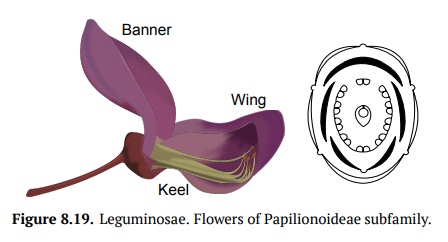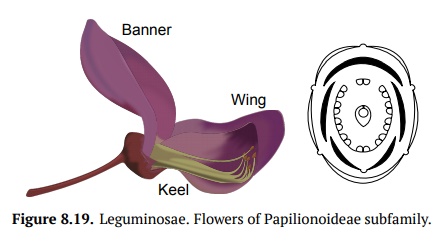Chapter: Introduction to Botany: The Origin of Flowering
Leguminosae, or Fabaceae - legume family

Leguminosae, or Fabaceae - legume family
Belong to rosids
(Rosidae). Up to 17,000 species, third largest angiosperm family after
Compositae (aster family) and Orchidaceae (orchids). Widely distributed
throughout the world, but preferably in tropics. Have root nodules with nitrogen-fixing bacteria. Leaves
alternate, pinnately compound (once or twice), with stipules.
Three subfamilies
(Caesalpinioideae, Mimosoideae, Papilionoideae) often treated as separate
families. Sepals 5, united. Petals 5, in Papilionoideae they are free, unequal
and have special names: banner, keel and wing (Fig. 8.19), in Mimosoideae
they fuse and form tube. Stamens often 10 with 9 fused and one free stamen; in
Mimosoideae, stamens are numerous. Singe pistil with single carpel. Flower
formula of Mimosoideae is

Papilionoid legumes
have formula like

Fruit is a legume
(pod): dehiscent with one camera. Mature seeds without endosperm.

Representatives of
Leguminosae:
•
Mimosoideae: stamens numerous, petals connected
– Acacia—dominant tree of
African and Australian savannas, often withphyllodes
– Mimosa—sensitive plant
•
Papilionoideae: stamens 9+1, petals free; this subfamily contains many
extremely important food plants with high protein value
– Glycine—soybean
– Arachis—peanut with
self-buried fruits
– Phaseolus—bean
– Pisum—pea
Related Topics